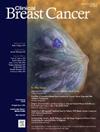Tumor Growth Rate of Luminal and Nonluminal Invasive Breast Cancer Calculated on MRI Imaging
IF 2.9
3区 医学
Q2 ONCOLOGY
引用次数: 0
Abstract
Purpose
Calculation of the size growth of different types of breast carcinoma based on follow-up data in breast MRI.
Patients and methods
Patients were included if they had been diagnosed with an invasive breast carcinoma in the current MRI (aMRI), and had also undergone a breast MRI (pMRI) with unsuspicious findings (MR BIRADS 1 or 2) within 5 years prior to diagnosis. If retrospective analysis of pMRI revealed signs of the current carcinoma, a quantitative one-dimensional-analysis of size progression of the carcinoma over time was performed, and growth rates for different tumor types were calculated.
Results
About 204 patients with 208 invasive breast carcinomas (74 luminal A, 105 luminal B, nonluminal 29) were included. In 129 carcinomas, there were signs of the current tumor in the pMRI. Based on the interval between pMRI and aMRI (average 21 months), the average tumor doubling time was 1126 days (3.1 years), 624 days (1.7 years), and 254 days (0.7 years) of luminal A, luminal B, and nonluminal. The average tumor size was 4.3 mm in the pMRI, and 9.5 mm in aMRI. In 79 cases, the pMRI showed no signs of the actual carcinoma. In this group, the average current tumor size was 8.5 mm.
Conclusion
The study provides specific information on the growth rate of luminal and nonluminal breast cancer. According to this, early detection intervals for nonhigh-risk women using MRI of 2 to 3 years, and for high-risk (HR) women of 1 year appear reasonable. Data also provide a well-founded basis for medico-legal judgements.
磁共振成像计算腔内与非腔内浸润性乳腺癌肿瘤生长速率。
目的:根据乳腺MRI随访资料计算不同类型乳腺癌的大小增长。患者和方法:如果患者在当前MRI (aMRI)中被诊断为浸润性乳腺癌,并且在诊断前5年内进行了乳房MRI (pMRI)检查,发现无可疑(MR BIRADS 1或2),则纳入患者。如果回顾性分析pMRI显示当前肿瘤的征象,则对肿瘤随时间的大小进展进行定量一维分析,并计算不同肿瘤类型的生长率。结果:共纳入208例浸润性乳腺癌204例,其中腔内A 74例,腔内B 105例,非腔内29例。在129例肿瘤中,pMRI显示当前肿瘤的征象。根据pMRI和aMRI之间的间隔(平均21个月),腔内A、腔内B和非腔内肿瘤的平均肿瘤倍增时间分别为1126天(3.1年)、624天(1.7年)和254天(0.7年)。pMRI平均肿瘤大小为4.3 mm, aMRI为9.5 mm。在79例中,pMRI未显示实际的癌征象。在这一组中,目前肿瘤的平均大小为8.5 mm。结论:该研究提供了关于腔内和非腔内乳腺癌生长速度的具体信息。据此,非高危女性MRI早期检测间隔为2 ~ 3年,高危女性MRI早期检测间隔为1年似乎是合理的。数据还为医学法律判断提供了有充分根据的依据。
本文章由计算机程序翻译,如有差异,请以英文原文为准。
求助全文
约1分钟内获得全文
求助全文
来源期刊

Clinical breast cancer
医学-肿瘤学
CiteScore
5.40
自引率
3.20%
发文量
174
审稿时长
48 days
期刊介绍:
Clinical Breast Cancer is a peer-reviewed bimonthly journal that publishes original articles describing various aspects of clinical and translational research of breast cancer. Clinical Breast Cancer is devoted to articles on detection, diagnosis, prevention, and treatment of breast cancer. The main emphasis is on recent scientific developments in all areas related to breast cancer. Specific areas of interest include clinical research reports from various therapeutic modalities, cancer genetics, drug sensitivity and resistance, novel imaging, tumor genomics, biomarkers, and chemoprevention strategies.
 求助内容:
求助内容: 应助结果提醒方式:
应助结果提醒方式:


